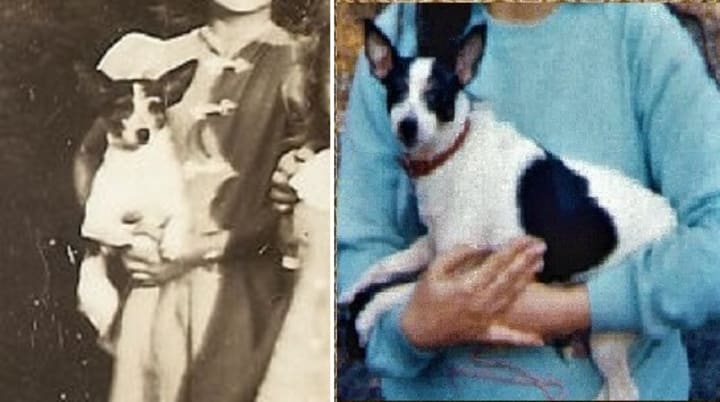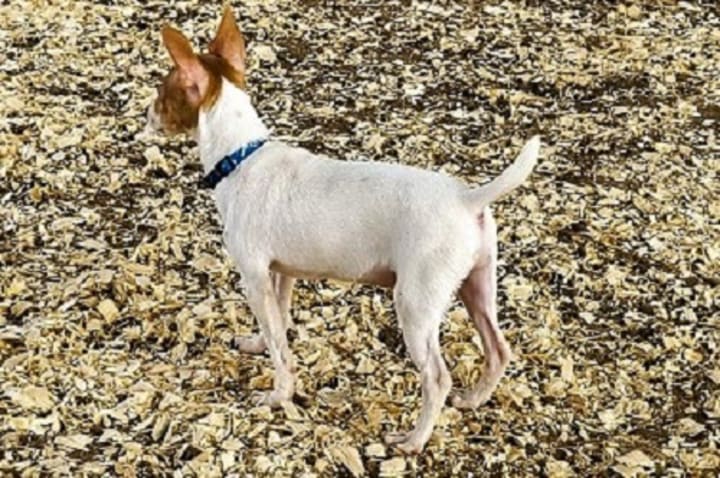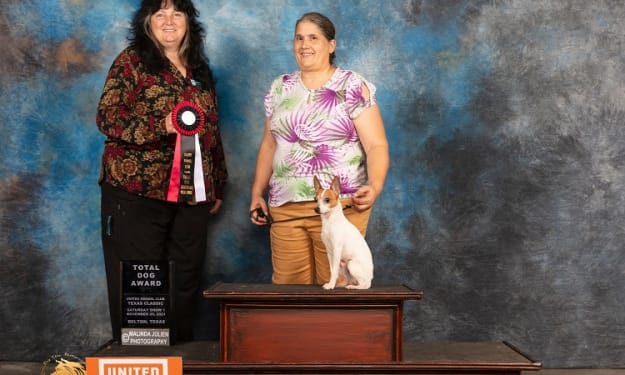What on Earth is a Toy Fox Terrier?
The terrier that doesn't know it's a toy!

If the Airedale is the "King of the Terriers," then the Toy Fox Terrier (TFT) perceives itself to be the Emperor of All Terrier Kind. TFTs are typically slightly larger than a Chihuahua, with show-quality dogs not exceeding 7 pounds or 11.5 inches at the shoulder, so they need to pack all of that confidence into a truly tiny package. They can be fun, exasperating, loving, exhausting, sweet, and challenging dogs. When someone comes to me looking for a puppy, the questionnaire they are required to fill out asks if they have previous dog experience. TFTs are small dogs but they are not beginner dogs. They are still terriers, with all that being a terrier implies.
A Brief History
Like all terriers, TFTs started out as farm dogs. Fox terrier breeders sometimes found runts in their litters. When some enterprising breeders discovered that these smaller dogs were just as tough as their larger siblings, they selectively bred them for small animal hunting and vermin control. TFTs made their debut before the fox terrier was split into two varieties: smooth and wire. For that reason, coarse "wire" coats occasionally pop up in the breed! The original TFTs were much larger than the current-day dogs and they did not have as much consistency of size.

The United Kennel Club (UKC) first recognized the TFT as a separate breed in 1938, which permitted fanciers of the smaller dogs to remove the larger fox terriers from their immediate gene pool. The National Toy Fox Terrier Association (NTFTA) was formed in 1949. The club acted as an umbrella for other clubs, bringing together fanciers from all over the nation to set the TFT standard in "stone" and to enhance the welfare of the breed. The NTFTA still does so today--and even includes member clubs from other nations. The NTFTA states that it is "dedicated to the preservation of the "American" Toy Fox Terrier" and supports breeder, judge, and public education, as well as sponsoring TFT specialty shows, to further that aim.
What do Toy Fox Terriers Look Like?
They are small, prick-eared dogs, typically under 11 inches at the high point of their shoulders. They have short, smooth coats that are somewhat hard to the touch. While some are tall and rangy and some are short and squat, all TFTs should be square from shoulder to tail and from shoulder to paw pads. All are piebald dogs, with a "base" coat of white and black or brown patches. Some dogs are more heavily marked than others (compare March to Widget, below), TFTs should have more than 50% color on their heads and less than 50% color on their bodies for the show ring.
Why Don't TFTs Look Like Other Fox Terriers?
When I tell people that I have a Toy Fox Terrier--as opposed to a Chihuahua cross or something similar--they almost always ask why the TFT looks so different from the Smooth Fox Terriers (SFTs) that they've seen on television. Usually, they specifically comment on the ears and the tail. The tail question is easy to answer: almost all terrier breeds have docked tails. The larger dogs from which TFTs were bred had longer docks that acted as "handles" for removing them from underground if they were stuck or in danger. The smaller dogs typically remained above ground to hunt small vermin, such as mice, rats, voles, and moles. Their tails were either undocked or docked to a shorter length to complement their smaller bodies. My dog, Widget, has a tail docked in a manner similar to the larger fox terrier. It looks fine on him, but not all small dogs can pull it off as well as he can.

It's harder to say why TFT founders failed to keep the tipped "button" ears. I can offer several theories, but there are no documented answers. I do know that, back when TFTs were also called "Ameritoys," they had both prick and button ears. Button ears rarely occur in modern (post 1970s) TFTs and are either a disqualification (AKC) or a serious fault (UKC) for show dogs.
- The term "fox terrier" was an umbrella term used for decades. It referred to any dog that was used to "go to ground" to flush foxes. The umbrella covered Jack Russell and Parson Russel terriers, as well as SFTs and WFTs, as well as crosses between the established breeds or lines of dogs. At the time, some fox terriers had "prick" (upright) ears, like today's TFT. Prick ears can still appear in the breeds mentioned above, although such ears are a disqualification for the show ring.
- Prick ears are the natural canine ear. Breeders typically developed dogs with button or drop ears to protect them from the elements. Terriers were developed with button ears to prevent dirt from getting in them when the dogs went to ground. Because things tend to drift toward the median and because TFTs did not need button ears, it was easier to stay with pricked ears instead of fighting nature.
- Related to number 2, small breeds such as the Chihuahua and the Miniature Pinscher were added to the TFT gene pool. These breeds also have erect ears. While the current TFT standard calls for different ear shape and placement from these other breeds, they put their genetic stamp on the developing TFT.
- Prick ears allow for a more "open" expression. As the TFT left the farm and became more popular as a show dog and a circus dog, prick ears may have become more popular. In addition, the triangular head topped by triangular ears give the TFT a roughly fox-like appearance, which may have appealed to some breeders.

What do Toy Fox Terriers do Today?
Most TFTs are currently pets or show dogs. They can still be good hunting dogs--there are squirrel champion hunting dogs in some TFT pedigrees--and they still have a strong instinct to hunt small rodents. I use mine to hunt rodents near my goats' feed, which they love to do. Their strong instinct to hunt and to seek out various scents makes them wonderful participants in barnhunt and nosework, as well. TFTs are often stellar athletes and shine in both agility and straight-line lure coursing (Fast CAT, drag racing).
Are Toy Fox Terriers Good Family Dogs?
They can be. TFTs are better pets for adults or for families with children over seven years or with teenagers. Like many dogs of their size, TFTs are more breakable than, for example, a Labrador retriever. Children must understand that TFTs should be treated with care, regardless of their age. In addition, TFTs can have the typical terrier temperament, which means they can get snappy if a child does something to annoy them. In short, they can make fine family companions, but they are not for everyone.
What Makes You Qualified to Write about the TFT?
I purchased my first TFT, Oma, in November of 1989. I purchased my first show quality TFT, Beau, in March of 2000. Since that time, I have had competed with them in various dog sports, as well as keeping them as pets. I have bred a few litters and have done extensive reading on TFT history and on dog genetics. I have had other breeds before discovering TFTs and still own other breeds. While other breeds may come and go from my life, I shall never be without a Toy Fox Terrier.
About the Creator
Kimberly J Egan
Welcome to LoupGarou/Conri Terriers and Not 1040 Farm! I try to write about what I know best: my dogs and my homestead. I currently have dogs, cats, dairy goats, quail, and chickens--and in 2025--rabbits! Come take a look into my life!






Comments
There are no comments for this story
Be the first to respond and start the conversation.